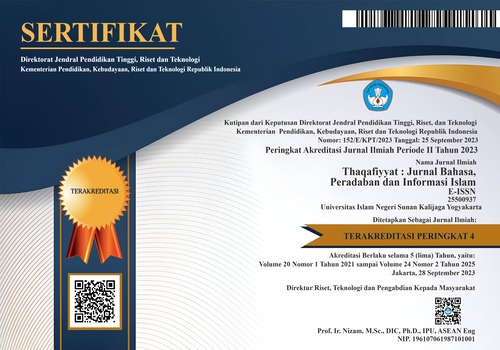KAUM SANTRI MOJOKUTO DAN KAUM SANTRI FRONT PEMBELA ISLAM (Studi Tentang Oposisi Biner: Kolot dan Modernis dalam Konsepsi Cliffor Geertz)
Abstract
Research on the influence of Arabic syntax to Malay language or
Indonesia language in 19th century is really difficult to be found. In fact, the 19th century is the century that is important in the assessment phase of the Indonesia grammar (Malay), because in this phase began many grammar books and dictionaries of Malay language, both written by Europeans (British-Dutch- French), as Marsden (1812), Crawfurd (1852), Favre (1875), Hollander (1882), and Wijk (1889), as well as written by the Malay people Raja Ali Haji (1850 and 1859).
There are fundamental differences between the grammar books written by the Dutch and the Malays. Books written by Europeans was Europe-centric, while the book written by the Malays are very Arab-centric. In fact, since Islam arrived in the archipelago, the influences of Arabic syntax are felt in the archipelago texts, especially religious texts. The fact that the Arabic influence is strong enough to precisely the Malay language syntax encourage Ronkel (1899) wrote an article entitled "Over Invloed der Arabische Syntaxis op de Maleische". Bustān al- Kātibīn is the first book written by country boy, who was very clearly demonstrated the influence of Malay language to Arabic language. The influence was not only in vocabulary, but also on the structure and rule of grammar.
Keywords: Syntax, Arabic language, Malay language
Downloads
Downloads
Published
Issue
Section
License
Authors who will publish with this journal agree to the following terms:
- Thaqafiyyat: Jurnal Bahasa, Peradaban dan Informasi Islam publishes all articles entirely in full text.
- It is permissible for readers to download and to use it for scientific purposes and scientific dissemination.
- Authors retain copyright and grant the journal right of first publication with the work simultaneously licensed under a Creative Commons Attribution License that allows others to share the work with an acknowledgement of the work's authorship and initial publication in this journal.
- Authors are able to enter into separate, additional contractual arrangements for the non-exclusive distribution of the journal's published version of the work (e.g., post it to an institutional repository or publish it in a book), with an acknowledgement of its initial publication in this journal.
- Authors are permitted and encouraged to post their work online (e.g., in institutional repositories or on their website) prior to and during the submission process, as it can lead to productive exchanges, as well as earlier and greater citation of published work.










